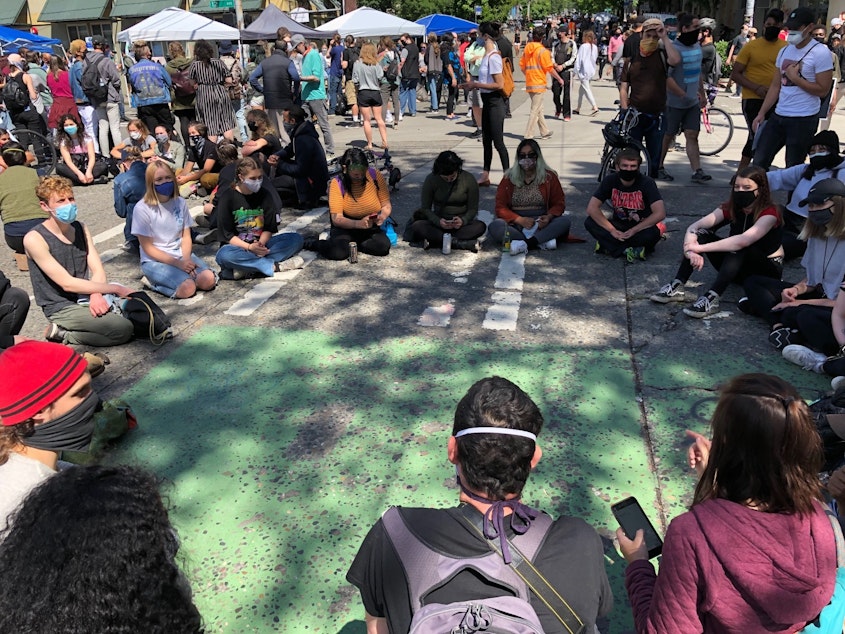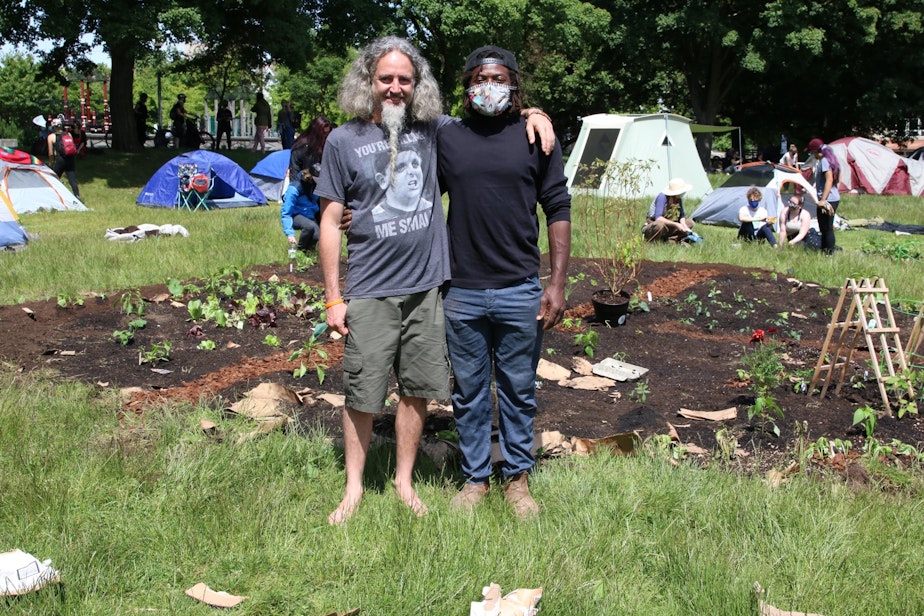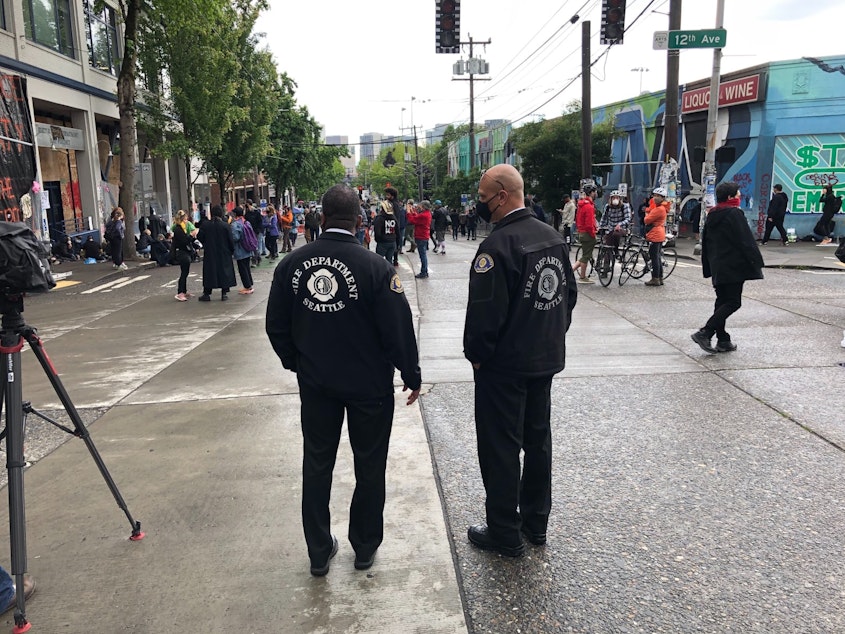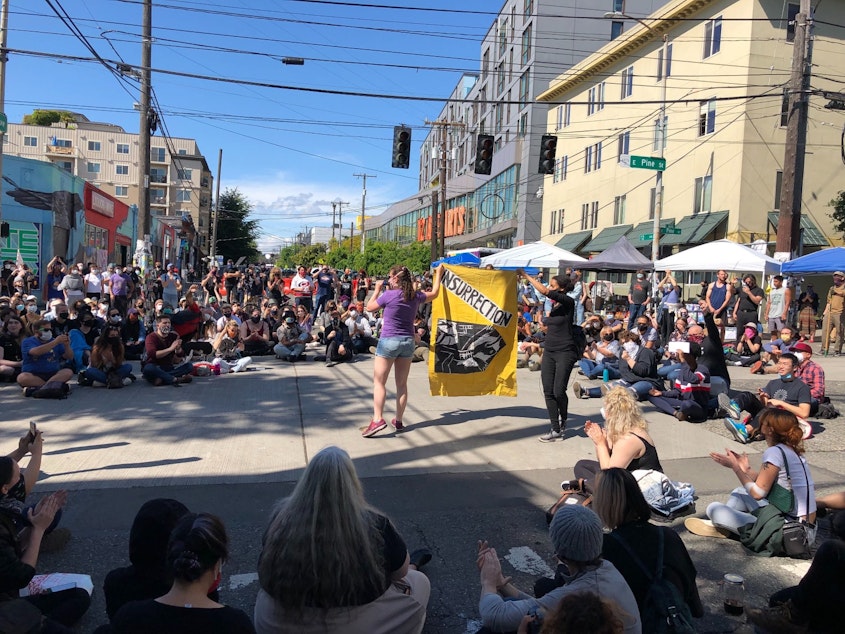CHAZ chews on what to do next

Capitol Hill’s new Autonomous Zone, known as CHAZ, is a six block area around 12th and Pine. Residents, business owners and activists are trying to figure out what’s next for this hard won territory.
“I feel like I’m in part of the civil rights movement,” said Lyn Idahosa-Berry of the Federal Way Black Collective, who came up to see it. “Martin, Rosa, they’re all here. You feel the ancestors. And they’re calling us to do better in their names.”
A few nights ago, police were lobbing tear gas and flash bangs at protesters here. But now, it’s like a busy town square, full of people walking, eating free food, painting murals.

On Thursday, neighbors and business owners said they like it better this way.
Jeff Scott owns a manufacturing business in the CHAZ, and had a front row seat to the protests and police response.
"It de-escalated pretty dramatically when the cops left the area. And this comes from a guy trying to remain as neutral as we can.”
Sponsored
Taha Ibrahimi lives in the CHAZ.
“I feel relieved to come out now," Ibrahimi said. "Before I was scared to leave my apartment. I was so happy when the precinct left because I could finally leave my apartment.”
Not everyone’s happy about it though. Nick Pennington, who supported the protesters early on with a financial donation, said he's developed concerns about the CHAZ itself while watching it evolve from his apartment window. He said the neighborhood’s gotten dirtier.
“Over in the park where all the tents are, there’s just a bunch of garbage,” he said.
So what does it mean, for this set of six city blocks to govern itself?
It means that a lot of people are volunteering their time. Like Chris Hong, who stands at the barrier at the edge of the zone. He doesn’t stop people from entering, but if a car tries to speed through, he might throw a bike rack in its path.
“I am a speed bump,” he said, “I am just a neighbor spending some time moving things in and out of the way so that all the traffic coming through will do so at a reasonable pace that will not threaten anybody’s safety.”
Down at Cal Anderson Park, Marcus Henderson had an idea for a community garden. So he brought a shovel and started digging.
“Everyone showed up with plants, and from there it’s been the community’s garden.”
Sponsored

Then there’s the big mural, painted on the street. Artists like Aramis Hamer are painting the letters different colors.
“Right now, I’m painting the letter V in Black Lives Matter,” Hamer said, “Which is an obvious statement, but here we are, in the middle of Capitol Hill, making it clear for anybody who was confused.”
When the CHAZ first emerged, allegations began to spread about businesses being asked to pay a fee to operate inside the area, even for protection. Of the many businesses interviewed, all denied this had taken place.
While police initially asked for businesses and residents to report such claims of extortion, officials confirmed with The Seattle Times that no such official reports came in.
Who's in charge here?
Not all decisions in the autonomous zone come so easily though. For example, the same barricades that keep police out also keep fire engines out. Fire Chief Harold Scoggins came down to try to work things out with organizers here.
“We’re trying to figure out a way of still supporting the first amendment rights, but also supporting the businesses and residents that live in the area,” Scoggins said.
He left without answers.

Sponsored
One seemingly easy decision – turned out to be hard. Should protesters form a ring around the police precinct building to keep officers out? Or should they form a looser ring, so cops can enter and exit freely? This was one of many conversations happening at 12th and Pine on Thursday.
Joseph Adams argued police should be able to access the building.
“I’m just saying we shouldn’t go about and block them from getting inside their building,” he said. “Because it’s going to cause a bigger problem."
"I live on 13th and Yesler, and they’ve got the National Guards parked over there, like four busloads," Adams said. "And Donald Trump is waiting."
“So we have to be careful ... what we’re doing in these streets,” he said. “I understand wanting to get our message across. But we’ve got to go about doing it in a different way.”
Kailie Sandstrom said the police should not come back.
“I don’t see why we would be so quick to say we’re going to give this back to you. The police need to back off and give us time to figure out what the community wants here."
Sponsored
One challenge here is that, while there are organizers who facilitate discussions, there’s no obvious leader making decisions. The group makes decisions.
Malcolm H, with Black Lives Matter Seattle, hopes to see a little more organization.
“It’s very important that we get a council going of elected representatives of the CHAZ zone," he told Sandstrom. "Since you guys are going to be our sovereign state, you guys have to get that going immediately.”

That afternoon, the CHAZ started working on that. People formed circles and started building consensus. There were discussions about what leadership should look like, and why.
“Is there a reason why we’re not designating any leaders, like, as a protesting movement?” one person asked.
Sponsored
“Leaders get taken out,” another person answered. “And we saw that a lot in Ferguson that a lot of the Black leadership, that were making themselves into spokespeople and stuff, that were explaining a lot of stuff, some of them died, a lot of them got locked up.”
Discussion groups gave preference to black and brown voices, who’ve been shut out of decisions for so long.
At several points in the day, conversations were halted so that people could "hold their ground," and in one case to eject someone allegedly discovered to have been live-streaming to a right wing group. Another time it was to confront police officers who had stuck their head out of the precinct building.
After these interruptions, it was back to the conversations such as what should happen to the police property.
“If they were to give this building up right here, you know what I’d turn it into?" said Joseph Adams.
"A little Black Silicon Valley” he answered, to prepare Black children to compete with white workers for tech jobs.
At the end of the day, there were still many major decisions to be made. But the people in the CHAZ say they’ll keep meeting every day, until they have these things hammered out.


